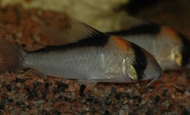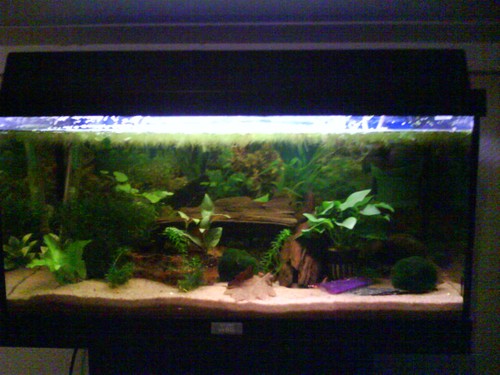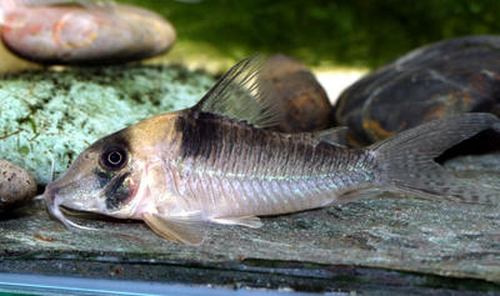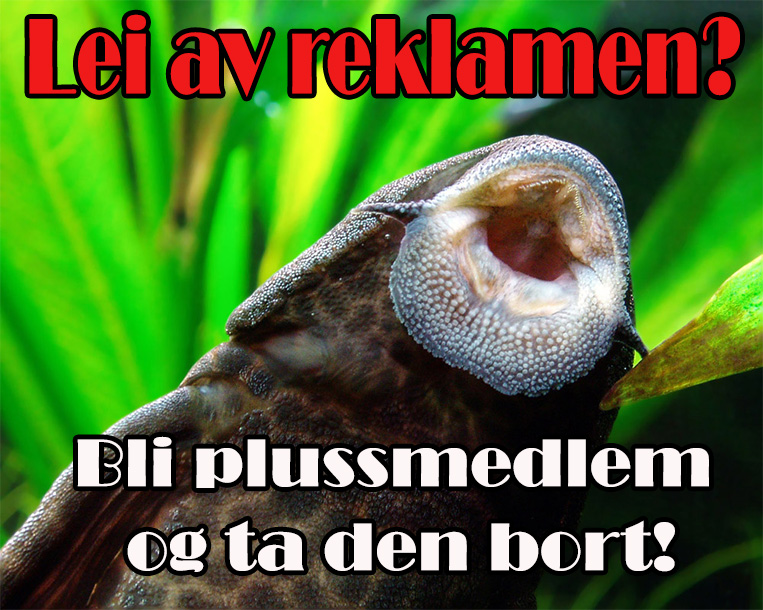- Hjem
- Forum
- Snegler/skalldyr
- Amanoreke med egg! noen gode råd?
Amanoreke med egg! noen gode råd?
Hei AF!
Nå har jeg fått se paringen og min mistanke ble bekreftet i dag! Jeg har en svær Amanoreke med et dusin av egg! Jeg vet at de formerer seg via den primitive måten altså i saltvann. Jeg vil gjerne vite hva slags salt jeg kan eller skal bruke, hvor mye, hva slags fôr (har mikroorm og avskallede artemia egg og div rekepellets) og evt anna viktig info.
Jeg bor jo i et av de få (er det ikke det eneste??) fylkene i landet som ikke har noe saltvann så jeg må "lage" saltvannet. En annen ting jeg vil vite er om det er verdt forsøket, hvor ofte jeg skal bytte vann og gjerne hvilken temperatur som er anbefalt. Karet de bor i har en temperatur på 23-24 grader.
Isbokser og yngelbokser har jeg nok av fordi jeg har noen kull med cory yngel jeg dretter akurat nå. Karet er innredet med lave planter og noen hurtigvoksende planter, røtter, små skifer plater på bunn (bare på et par steder), forstenet tre, en salig blanding av Pistia Stratoies, Salvinia Minima og Andemat, Aquaball pumpe (vet ikke hvilken modell) og greie vannbyttingsrutiner. Det går noen små Coryyngel på 2-3 uker og CRS reker. Det er 54 liter vann i karet og det har heldekkende armatur. Det er av merket Juwel med sort møbel.
Jeg forer med Rekepellets og litt mikroorm for de små ynglene i karet. Reken med egg er veldig aktiv og farter rundt og noe mer aktiv enn vanlig. I tilleg har jeg merket noe agressivitet fra denne reken i dag men ikke noe å skryte av..
Takk for svar!
Nå har jeg fått se paringen og min mistanke ble bekreftet i dag! Jeg har en svær Amanoreke med et dusin av egg! Jeg vet at de formerer seg via den primitive måten altså i saltvann. Jeg vil gjerne vite hva slags salt jeg kan eller skal bruke, hvor mye, hva slags fôr (har mikroorm og avskallede artemia egg og div rekepellets) og evt anna viktig info.
Jeg bor jo i et av de få (er det ikke det eneste??) fylkene i landet som ikke har noe saltvann så jeg må "lage" saltvannet. En annen ting jeg vil vite er om det er verdt forsøket, hvor ofte jeg skal bytte vann og gjerne hvilken temperatur som er anbefalt. Karet de bor i har en temperatur på 23-24 grader.
Isbokser og yngelbokser har jeg nok av fordi jeg har noen kull med cory yngel jeg dretter akurat nå. Karet er innredet med lave planter og noen hurtigvoksende planter, røtter, små skifer plater på bunn (bare på et par steder), forstenet tre, en salig blanding av Pistia Stratoies, Salvinia Minima og Andemat, Aquaball pumpe (vet ikke hvilken modell) og greie vannbyttingsrutiner. Det går noen små Coryyngel på 2-3 uker og CRS reker. Det er 54 liter vann i karet og det har heldekkende armatur. Det er av merket Juwel med sort møbel.
Jeg forer med Rekepellets og litt mikroorm for de små ynglene i karet. Reken med egg er veldig aktiv og farter rundt og noe mer aktiv enn vanlig. I tilleg har jeg merket noe agressivitet fra denne reken i dag men ikke noe å skryte av..
Takk for svar!
Postet 12.11.08 kl 14:48
Amano
Salt kan du få kjøpt i akvarieforetninger, eller muligens fra matvare butikk "uten jod"
Her er et utkast fra www.aqua-fish.net
Breeding caridina japonica is quite easy. Sexual dimorphism is really evident: adult males reach 3cm while females are bigger and reach 5-6 cm. Females have a six – eight weeks long cycle, when they are ready to breed they produce sex pheromones, that make change the behaviour of males in the tank: you can understand that a female is ready because males start swimming almost without control around all the tank trying to find the female. Females keep eggs for five weeks and then hatches hundreds of larvae.
Larvae growing is much bigger problem in Caridina breeding because they are really small, almost invisible and eat only phytoplankton. Phytoplankton is made of small vegetable organisms present in the water, it is almost impossible to find them bottled in shops, anyway it can be naturally present in mature aquariums. The other problem with larvae is that being such small they surely end in the filter or in the mouth of fish, so the only solution is to breed in a separated tank.
You can set up a 20 litres small tank without gravel on the ground and with some hiding places, both natural or artificial; it is important not to put a filter, you can use a small oxygenator at its place. Before breeding, it is important to get the future larvae food; You have various options, anyway a good working solution is to put a small tank of water under direct sunlight outside your house, when water gets green for algae you can start breeding because this mean that water is full of phytoplankton.
Put a carrying eggs female with two or more males for some days, you should be able to see them mating, because males tend to cover the female the most of the time. When the female hatches the larvae you can take her back in the aquarium with other caridina.
From this point take some green water of the “food tank” with a syringe without needle and add it in the breeding tank. Do this daily even more times at day.
When they reach two or three weeks of age, they start to be visible and you can try to add some small quantities of spirulina powder or powered fish food. At around six week of age they do the first moult and begin to look like adult Caridina, at this point you can feed them with the same adult food as well and can decide to put them in the community tank in case there are a good number of hiding places.
As mentioned above, breeding is quite easy, problem with larvae will be surely solved with the personal experience. Bear in mind that caridina are able to breed about every two months and if kept, you probably have some females in your tank, so it gives them the chance to breed often.
Her er et utkast fra www.aqua-fish.net
Breeding caridina japonica is quite easy. Sexual dimorphism is really evident: adult males reach 3cm while females are bigger and reach 5-6 cm. Females have a six – eight weeks long cycle, when they are ready to breed they produce sex pheromones, that make change the behaviour of males in the tank: you can understand that a female is ready because males start swimming almost without control around all the tank trying to find the female. Females keep eggs for five weeks and then hatches hundreds of larvae.
Larvae growing is much bigger problem in Caridina breeding because they are really small, almost invisible and eat only phytoplankton. Phytoplankton is made of small vegetable organisms present in the water, it is almost impossible to find them bottled in shops, anyway it can be naturally present in mature aquariums. The other problem with larvae is that being such small they surely end in the filter or in the mouth of fish, so the only solution is to breed in a separated tank.
You can set up a 20 litres small tank without gravel on the ground and with some hiding places, both natural or artificial; it is important not to put a filter, you can use a small oxygenator at its place. Before breeding, it is important to get the future larvae food; You have various options, anyway a good working solution is to put a small tank of water under direct sunlight outside your house, when water gets green for algae you can start breeding because this mean that water is full of phytoplankton.
Put a carrying eggs female with two or more males for some days, you should be able to see them mating, because males tend to cover the female the most of the time. When the female hatches the larvae you can take her back in the aquarium with other caridina.
From this point take some green water of the “food tank” with a syringe without needle and add it in the breeding tank. Do this daily even more times at day.
When they reach two or three weeks of age, they start to be visible and you can try to add some small quantities of spirulina powder or powered fish food. At around six week of age they do the first moult and begin to look like adult Caridina, at this point you can feed them with the same adult food as well and can decide to put them in the community tank in case there are a good number of hiding places.
As mentioned above, breeding is quite easy, problem with larvae will be surely solved with the personal experience. Bear in mind that caridina are able to breed about every two months and if kept, you probably have some females in your tank, so it gives them the chance to breed often.
Postet 12.11.08 kl 14:58
Postet 12.11.08 kl 15:39




